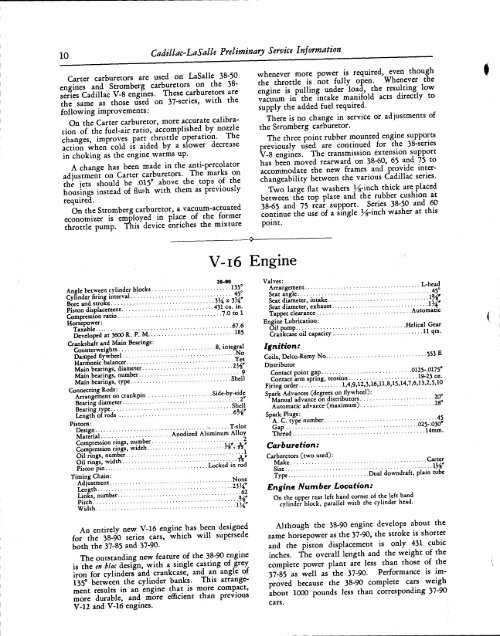1938 Cadillac V16 - GM Heritage Center
1938 Cadillac V16 - GM Heritage Center
1938 Cadillac V16 - GM Heritage Center
You also want an ePaper? Increase the reach of your titles
YUMPU automatically turns print PDFs into web optimized ePapers that Google loves.
10<br />
<strong>Cadillac</strong>-LaSaile Preliminary Service Information<br />
Carter carburetors are used on LaSalle 38-50<br />
engines and Stromberg carburetors on the 38-<br />
series <strong>Cadillac</strong> V-8 engines. These carburetors are<br />
the same as those used on 37-series, with the<br />
following improvements:<br />
On the Carter carburetor, more accurate calibration<br />
of the fuel-air ratio, accomplished by nozzle<br />
changes, improves part throttle operation. The<br />
action when cold is aided by a slower decrease<br />
in choking as the engine warms up.<br />
A change has been made in the anti-percolator<br />
adjustment on Carter carburetors. The marks on<br />
the jets should be .015" above the tops of the<br />
housings instead of fluFh with them as previously<br />
required.<br />
On the Stromberg carburetor, a vacuum-actuated<br />
economizer is employed in place of the former<br />
throttle pump. This device enriches the mixture<br />
whenever more power is required, even though<br />
the throttle is not fully open. Whenever the<br />
engine is pulling under load, the resulting low<br />
vacuum in the intake manifold acts directly to<br />
supply the added fuel required.<br />
There is no change in service or ad justments of<br />
the Stromberg carburetor.<br />
The three point rubber mounted engine supports<br />
previously used are continued for the 38-series<br />
V-8 engines. The transmission extension support<br />
has been moved rearward on 38-60, 65 and 75 to<br />
accommodate the new frames and provide interchangeability<br />
between the various <strong>Cadillac</strong> series.<br />
Two large flat washers ^j-inch thick are placed<br />
between the top plate and the rubber cushion at<br />
38-65 and 75 rear support. Series 38-50 and 60<br />
continue the use of a single )^-inch washer at this<br />
point.<br />
V-i6 Engine<br />
38.90<br />
Angle between cylinder blocks 135°<br />
Cylinder firing interval 45°<br />
Bore and stroke 3¾ x 3½"<br />
Piston displacement<br />
431 cu. in.<br />
Compression ratio 7.0 to 1<br />
Horsepower:<br />
Taxable 67.6<br />
Developed at 3600 R. P. M 185<br />
Crankshaft and Main Bearings:<br />
Counterweights<br />
8, integral<br />
Damped flywheel No<br />
Harmonic balancer<br />
Yes<br />
Main bearings, diameter 2H"<br />
Main bearings, number 9<br />
Main bearings, type<br />
Shell<br />
Connecting Rods:<br />
Arrangement on crankpin<br />
Side-by-side<br />
Bearing diameter 2"<br />
Bearing type<br />
Shell<br />
Length of rods 6%"<br />
Pistons:<br />
Design ;• T-slot<br />
Material<br />
Anodized Aluminum Alloy<br />
Compression rings, number 2<br />
Compression rings, width Jtj", A"<br />
Oil rings, number 1<br />
Oil rings, width<br />
&"<br />
Piston pin<br />
Locked in rod<br />
Timing Chain:<br />
Adjustment<br />
None<br />
Length 23½"<br />
Links, number 62<br />
Pitch H"<br />
Width 1¾"<br />
An entirely new V-16 engine has been designed<br />
for the 38-90 series cars, which will supersede<br />
both the 37-85 and 37-90.<br />
The outstanding new feature of the 38-90 engine<br />
is the en bloc design, with a single casting of grey<br />
iron for cylinders and crankcase, and an angle of<br />
135° between the cylinder banks. This arrangement<br />
results in an engine that is more compact,<br />
more durable, and more efficient than previous<br />
V-12 and V-16 engines.<br />
Valves:<br />
Arrangement<br />
L-head<br />
Seat angle 45°<br />
Seat diameter, intake<br />
1¾'<br />
Seat diameter, exhaust 1M"<br />
Tappet clearance<br />
Automatic<br />
Engine Lubrication:<br />
Oil pump<br />
Helical Gear<br />
Crankcase oil capacity<br />
11 qts.<br />
Ignition:<br />
Coils, Delco-Remy No<br />
553 E<br />
Distributor<br />
Contact point gap 0125-.0175*<br />
Contact arm spring, tension<br />
19-23 oz.<br />
Firing order 1,4,9,12,3,16,11,8,15,14,7,6,13,2,5,10<br />
Spark Advances (degrees on flywheel):<br />
Manual advance on distributors 20°<br />
Automatic advance (maximum) 28°<br />
Spark Plugs:<br />
A. C. type number 45<br />
Gap 025-030"<br />
Thread<br />
14mm.<br />
Carburetion:<br />
Carburetors (two used):<br />
Make<br />
Carter<br />
Size 1¼"<br />
Type<br />
Dual downdraft, plain tube<br />
Engine Number Location:<br />
On the upper rear left hand corner of the left hand<br />
cylinder block, parallel with the cylinder head.<br />
Although the 38-90 engine develops about the<br />
same horsepower as the 37-90, the stroke is shorter<br />
and the piston displacement is only 431 cubic<br />
inches. The overall length and the weight of the<br />
complete power plant are less than those of the<br />
37-85 as well as the 37-90. Performance is improved<br />
because the 38-90 complete cars weigh<br />
about 1000 pounds less than corresponding 37-90<br />
cars.
















